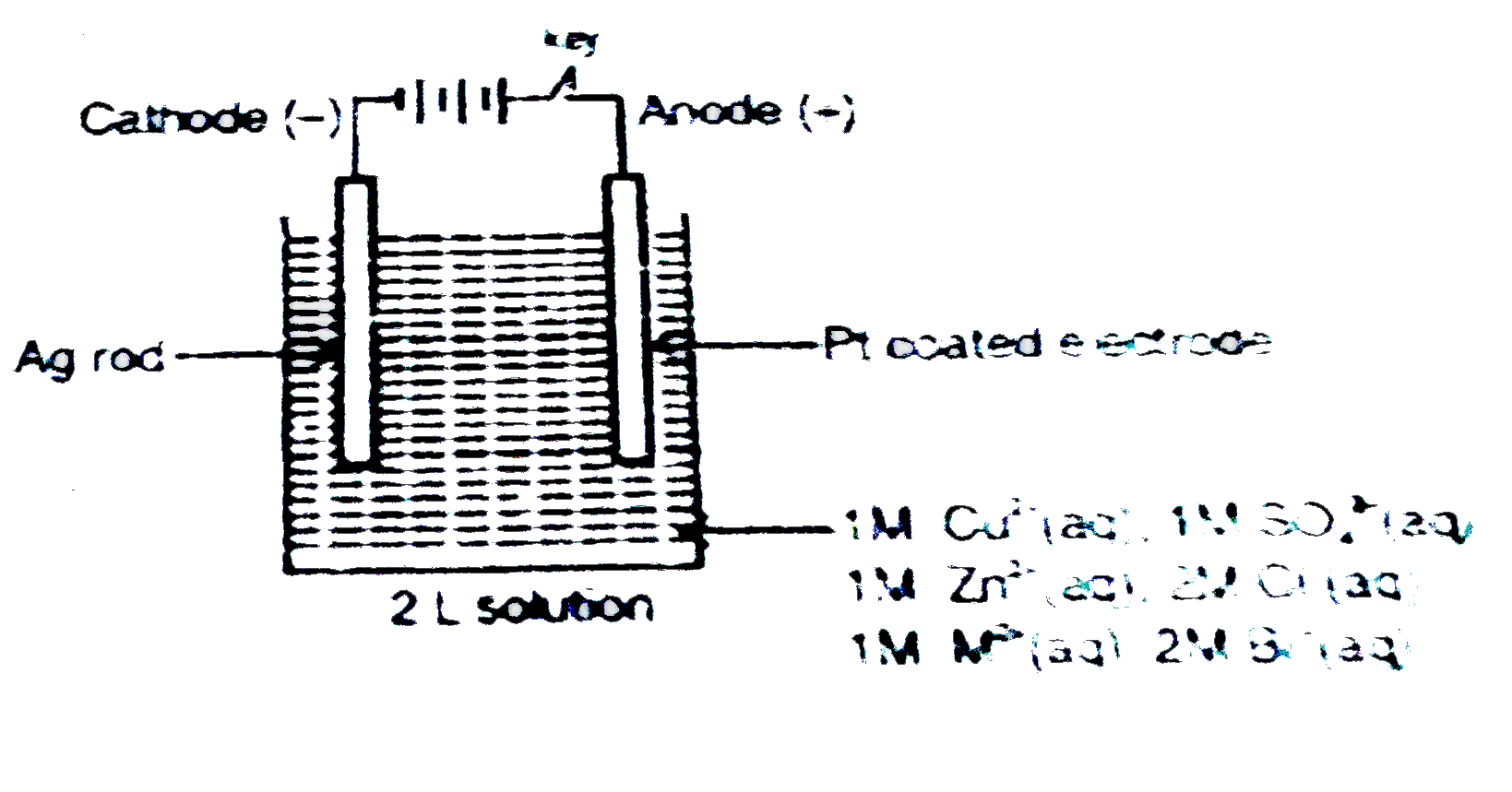3.8 of motlesn SnCI2 is electroysed for some time using insert electrodes 0.238 g of Sn is deposited at cathode No substance is lost during the eletroysis find the ratio of weight of SnCI2 and SnCI4 after electroysis (Sn=11)
SnCI2→Sn+2+2CI−
Sn+2+2e−→Sn
Mass of Sn deposited =0.238 g
m=Z it =ZQ
Charge Q=mz=m×n×fAt.wt
Q=0.238119×2×96500
Q=386 columb
For chrone 2CI−→CI2+2e
Mass mCI2=Zit=71nF×Q
=712×96500×386=0.142g
To calculate weight of SnCI4 produced
SnCI2+CI2→SnCI4
nCI21=nSnCI41
→mSnCI4261=0.002
→MSnCI4=0.522g
To calculate weightr of SnCI2 consumed
SnCI2+CI2→SnCI4
NSnCI21=nCI21=0.002
MSnCI2=0.002×190=0.38g
mSnCI2(remaining)=3.8−0.38−0.98=3.04g
Weight ratio=SnCI2SnCI4=3.040.522=5.829
Topper's Solved these Questions
- BOOK - AAKASH INSTITUTECHAPTER - ELECTROCHEMISTRY EXERCISE - Try Yourself19videos
ELECTROCHEMISTRY
- BOOK - AAKASH INSTITUTECHAPTER - ELECTROCHEMISTRY EXERCISE - Assignment (SECTION A) Objective Type Questions (One option is correct)43videos
ELECTROCHEMISTRY
- BOOK - AAKASH INSTITUTECHAPTER - COORDINATION COMPOUNDS EXERCISE - Assignment (Section-J Aakash Challenger Questions )10videos
COORDINATION COMPOUNDS
- BOOK - AAKASH INSTITUTECHAPTER - ENVIRONMENTAL CHEMISTRYEXERCISE - ASSIGNMENT (SECTION-D) (Assertion - Reason Type Questions)5videos
ENVIRONMENTAL CHEMISTRY
Similar Questions
19 g of molten SnCl2 is electrolysed for same tine, using inert electrodes. 0.119 g of Sn is deposited at the cathode. No substance is lost during the electrolysis. Find the ratio of the weight of SnCl2 and SnCl2 after electrolysis (Sn = 119)
View Solution19 g of molten SuCl2 is electrolysed for some time using inert electrodes until 0.119 g of Sn is deposited at the cathode. No substance is lost during electrolysis. Find the ratio of the masses of SnCl2:SnCl4 after electrolysis.
View Solution
Knowledge Check
- Question 1 - Select One
19 g of molten SnCl2 is electrolysed for sometime using inert electrodes. 0.119g of Sn is deposited at the cathode. No substance is lost during the electrolysis. The ratio of the weights of SnCl2 : SnCl4 after electrolysis [Atomic weight of Sn=119]
A71.34:1B31.34:1C7.134:1DNone of these - Question 2 - Select One
Salts of metals X, Y and Z are electrolysed under identical condition using same quantity of electricity . If was observed that 4.2 g of X, 5.4 g of Y and 19.2 g of Z were deposited at respetive cathode . If the atomic weights of X , Y, Z are 7, 27 and 64 respectively , then their ratio of valencies is
A1:2:3B1:3:2C2:3:1D3:2:2 - Question 3 - Select One
The process of using an electric current to bring about chemical change is called electrolysis.Electrolysis is a processes of oxidation and reduction at the respective electrodes due to external current passed in the electrolyte.
The product obtained during electrolysis depends on following factors.
The nature of the electrolyte
The concentration of electrolyte
The nature of the electrode.
Consider the electrolysis of following cell containing aq. solution of CuSO4,ZnCl2 and MBr2 by using pure silver rod as a cathode and Pt electrode as anode.Assume that M2+ does not further oxidise and can not form complex with NH3 Assume no hydrolysis of any ion.
E0Cu2+/Cu=0.35V,E0M2+/M=−0.10V,E0Zn2+/Zn=−0.76V,E0H2O/H2=−0.828V,E0Ag+/Ag=0.80V,2.303RTF=0.06
What will be the volume of gases formed at anode at STP by electrolysis of above solution after passing 20 amp current for 28950 sec. (Assume current efficiency to be 100% and one mole of gas occupies 22.4 L volume at STP).
 A44.8LBr2B22.4LBr2C22.4LCl2D44.8LCl2
A44.8LBr2B22.4LBr2C22.4LCl2D44.8LCl2
19g fused SnCl2 was electrolysed using inert electrodes. 0.119gSn was deposited at cathode. If nothing was given out during electrolysis, calculate the ratio of weight of SnCl2 and SnCl4 in fused state after electrolysis. (At. Wt. Sn=119)
View Solution18.97g fused SnCl20 was electrolyzed using inert electrodes. 1.187gSn was deposited at cathode. If nothing is obtained during electrolysis, calculate the ration of weight of SnCl2 and SnCl4 in fused state after electrolysis.
Given:
Atomic weight of Sn=118.7,Mwof SnCl2=189.7,Mw of SnCl4=260.7View SolutionApplication of Faraday's laws: An acidic solution of Cu2+ salt containing 0.4g of Cu2+ is electroysed until all the copper is deposited. The electrolysis is futher continueed for seven more minutes with the volume of the solution kept at 100mL and the current at 1.0amp. Calculate the volumes of gases evolved at NTP during the entire electrolysis.
Strategy: Since we do not know which Cu2+ salt is electrolysed, we can say that (in the first stage of electrolysis)Cu2+ is reduced at the cathode to deposit Cu while H2O is oxidized to liberate Og at the anode. In the second stage of electrolysis, only water gets oxidized to librate Og as well as reduced to librate H2gView SolutionPerdisulphuric acid (H2S2O8) or Marshall's acid can be prepared by the electrolytic oxidation of H2SO4. AT anode O2 and H2 are obtained as side products. After passing a current of 0.5 A for a certain time, the volume of H2 and O2 collected was found to be 10.08 and 2.24 L, respectively, at STP. What is the weight of H2S2O8 produced during the same time? Also find the duration of electrolysis (in seconds) assuming 75% efficiency of electronysis. Give all the electronde reaction.
View SolutionElectrolysis is a phenomenon where a reaction is carried out by passing electricity through the molten electrolyte or the electrolytic solution in water. In electrolysis, electrolyte first decomposes into anions and cations and thereafter anions undergo oxidation at anode and cations undergo reduction at cathode. for example.
XY (molten ) ⇔Xn++Yn−
Oxidation at anode : Yn−−ne−→Y
Reduction at cathode Xn++ne−→X
In order to predict the electrolytic products accurately an array of substances is arranged in decreasing order tendency of oxidation of the substances or increasing order of standard reducton potential in electrochemical series. the standard electrode potentials of some species (elements,or ions) is given as under.
Cl2(g)+2e−→2Cl−,E∘=1.360V
Na++e−→Na,E∘=−2.71V
2H2O+e−→H2(g)+2OH−,E∘=−0.83V
2H++2e−→H2,E∘=OV
When aqueous solution of 100mL of 1M NaCl is electrolysed using Pt electrodes then answer the following question.
What will b e the pH of the resulting solution upon passage of 0.2F chargeView Solution
